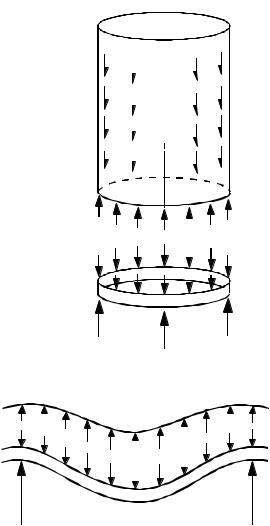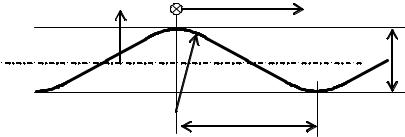
EN сталь / TKP EN 1993-4-1-2009
.pdf
EN 1993-4-1:2007 (Е)
(2) For 'product type' silos (factory production), which are subject to full scale testing, 'deemed-to- satisfy' criteria may be adopted for design purposes.
2.9 Action effects for limit state verifications
2.9.1General
(1)P The general requirements set out in section 9 of EN 1990 shall be satisfied.
2.9.2Partial factors for ultimate limit states
2.9.2.1Partial factors for actions on silos
(1)P For persistent, transient and accidental design situations, the partial factors γF shall be taken from EN 1990 and EN 1991-4.
(2) Partial factors for ‘product type’ silos (factory production) may be specified by the appropriate authorities.
NOTE: When applied to ‘product type’ silos, the factors in (1) are for guidance purposes only. They are provided to show the likely levels needed to achieve consistent reliability with other designs.
2.9.2.2Partial factors for resistances
(1)Where structural properties are determined by testing, the requirements and procedures of EN 1990 should be adopted.
(2)Fatigue verifications should satisfy section 9 of EN 1993-1-6.
(3)P The partial factors γMi for different limit states shall be taken from table 2.2.
Table 2.2: Partial factors for resistance
Resistance to failure mode |
Relevant |
|
γ |
|
|
Resistance of welded or bolted shell wall to |
γM0 |
plastic limit state |
|
Resistance of shell wall to stability |
γM1 |
Resistance of welded or bolted shell wall to |
γM2 |
rupture |
|
Resistance of shell wall to cyclic plasticity |
γM4 |
Resistance of connections |
γM5 |
Resistance of shell wall to fatigue |
γM6 |
NOTE: Partial factors γMi for silos may be defined in the National Annex. For values of γM5, further information may be found in EN 1993-1-8. For values of γM6, further information may be found in EN 1993-1-9. The following numerical values are recommended for silos:
γM0 = 1,00 |
γM1 = 1,10 |
γM2 = 1,25 |
γM4 = 1,00 |
γM5 = 1,25 |
γM6 = 1,10 |
For further differentiation, see 2.2(1) and 2.2(3)
16
EN 1993-4-1:2007 (Е)
2.9.3Serviceability limit states
(1) Where simplified compliance rules are given in the relevant provisions dealing with serviceability limit states, detailed calculations using combinations of actions need not be carried out.
2.10 Durability
(1)The general requirements set out in 2.6 of EN 1990 should be followed.
2.11 Fire resistance
(1)The provisions set out in EN 1993-1-2 for fire resistance should be met.
17
EN 1993-4-1:2007 (Е)
3Properties of materials
3.1 General
(1)All steels used for silos should be suitable for welding to permit later modifications when necessary.
(2)All steels used for silos of circular planform should be suitable for cold forming into curved sheets or curved members.
(3)The material properties given in this section, see Table 3.1 in EN 1993-1-1 and Table 3.1b in EN 1993-1-3, should be treated as nominal values to be adopted as characteristic values in design calculations.
(4)Other material properties are given in the relevant Reference Standards defined in EN 1993-1-1.
(5)Where the silo may be filled with hot solids, the values of the material properties should be appropriately reduced to values corresponding to the maximum temperatures to be encountered.
(6)Where the temperature exceeds 100°C, the material properties should be obtained from EN 13084-7.
3.2 Structural steels
(1)The methods for design by calculation given in this Part 4.1 of EN 1993 may be used for structural steels as defined in EN 1993-1-1, which conform with the European Standards and International Standards listed in table 3.1.
(2)The mechanical properties of structural steels, according to EN 10025 or EN 10149 should be obtained from EN 1993-1-1, EN 1993-1-3 and EN 1993-1-4.
(3)Corrosion and abrasion allowances are given in section 4 of this Part 4.1.
(4)It should be assumed that the properties of steel in tension are the same as those in compression.
(5)For the steels covered by this Part 4.1 of EN 1993, the design value of the modulus of elasticity should be taken as E = 210 000 MPa and Poisson’s ratio as ν = 0,3.
3.3 Stainless steels
(1)The mechanical properties of stainless steels should be obtained from EN 1993-1-4.
(2)Guidance for the selection of stainless steels in view of corrosion and abrasion actions of stored solids may be obtained from appropriate sources.
(3)Where the design involves a buckling calculation, appropriate reduced properties should be used (see EN 1993-1-6).
3.4 Special alloy steels
(1) For non-standardised alloy steels, appropriate values of relevant mechanical properties should be defined.
NOTE: The National Annex may give information on appropriate values.
18
EN 1993-4-1:2007 (Е)
(2)Guidance for the selection of non-standardised alloy steels with respect to the corrosion and abrasion actions of stored solids should be obtained from appropriate sources.
(3)Where the design involves a buckling calculation, appropriate reduced properties should be used (see EN 1993-1-6).
3.5 Toughness requirements
(1)The toughness requirements for the steels should be determined according to EN 1993-1-10.
19
EN 1993-4-1:2007 (Е)
4Basis for structural analysis
4.1 Ultimate limit states
4.1.1Basis
(1) Steel structures and components should be so proportioned that the basic design requirements given in section 2 are satisfied.
4.1.2Required checks
(1)P For every relevant limit state, the design shall satisfy the condition:
Sd < Rd
... (4.1)
where S and R represent any appropriate parameter.
4.1.3Fatigue and cyclic plasticity - low cycle fatigue
(1)Parts of the structure subject to severe local bending should be checked against the fatigue and cyclic plasticity limit states using the procedures of EN 1993-1-6 and EN 1993-1-7 as appropriate.
(2)Silos in Consequence Class 1 need not be checked for fatigue or cyclic plasticity.
4.1.4Allowance for corrosion and abrasion
(1) The effects of abrasion of the stored solid on the walls of the container over the life of the structure should be included in determining the effective thickness of the wall for analysis.
(2) Where no specific information is available, the wall should be assumed to lose an amount ta of its thickness due to abrasion at all points on contact with moving solid.
NOTE: The National Annex may choose the value of ta. The value ta = 2mm is recommended.
(3)The effects of corrosion of the wall in contact with the stored solid over the life of the structure should be included in determining the effective thickness of the wall for analysis.
(4)Specific values for corrosion and abrasion losses, appropriate to the intended use, should be agreed between the designer, the client and the relevant authority, taking account of the intended use and the nature of the solids to be stored.
NOTE 1: The National Annex may choose appropriate values for corrosion and abrasion losses for particular solids in frictional contact with defined silo wall materials, recognising the mode of solids flow defined in EN 1991-4.
NOTE 2: To ensure that the design assumptions are met in service, appropriate inspection measures have to be instituted.
4.1.5Allowance for temperature effects
(1) Where hot solids are stored in the silo, the effects of differential temperature between parts of the structure in contact with hot material and those that have cooled should be included in determining the stress distribution in the wall.
20

EN 1993-4-1:2007 (Е)
4.2 Analysis of the structure of a shell silo
4.2.1Modelling of the structural shell
(1)The modelling of the structural shell should follow the requirements of EN 1993-1-6. They may be deemed to be satisfied by the following provisions.
(2)The modelling of the structural shell should include all stiffeners, large openings, and attachments.
(3)The design should ensure that the assumed boundary conditions are satisfied.
4.2.2Methods of analysis
4.2.2.1General
(1)The analysis of the silo shell should be carried out according to the requirements of EN 1993-1-
6.
(2)A higher class of analysis may always be used than that defined for the Consequence Class.
4.2.2.2Consequence Class 3
(1) For silos in Consequence Class 3 (see 2.3), the internal forces and moments should be determined using a validated numerical analysis (finite element shell analysis) (as defined in EN 1993-1-6). Plastic collapse strengths under primary stress states may be used in relation to the plastic limit state as defined in EN 1993-1-6.
4.2.2.3Consequence Class 2
(1)For silos in Consequence Class 2 under conditions of axisymmetric actions and support, one of two alternative analyses may be used:
a)Membrane theory may be used to determine the primary stresses. Bending theory elastic expressions may be used to describe all local bending effects.
b)A validated numerical analysis may be used (e.g. finite element shell analysis) (as defined in EN 1993-1-6).
(2)Where the design loading from stored solids cannot be treated as axisymmetric, a validated numerical analysis should be used.
(3)Notwithstanding paragraph (2), where the loading varies smoothly around the shell causing global bending only (i.e. in the form of harmonic 1), membrane theory may be used to determine the primary stresses.
(4)For analyses of actions due to wind loading and/or foundation settlement and/or smoothly varying patch loads (see EN 1991-4 for thin walled silos), semi-membrane theory or membrane theory may be used.
(5)Where membrane theory is used to find the primary stresses in the shell:
a)Discrete rings attached to an isotropic cylindrical silo shell under internal pressure may be deemed to have an effective area which includes a length of shell above and below the
ring of 0.78 rt except where the ring is at a transition junction.
b)The effect of local bending stresses at discontinuities in the shell surface and supports should be evaluated separately.
21

EN 1993-4-1:2007 (Е)
(6) Where an isotropic shell wall is discretely stiffened by vertical stiffeners, the stresses in the stiffeners and the shell wall may be calculated by treating the stiffeners as smeared on the shell wall,
provided the spacing of the stiffeners is no wider than nvs rt.
NOTE: The National Annex may choose the value of nvs. The value nvs = 5 is recommended.
(7)Where smeared stiffeners are used, the stress in the stiffener should be determined making proper allowance for compatibility between the stiffener and the wall and including the effect of the wall membrane stress in the orthogonal direction.
(8)Where a ring girder is used above discrete supports, membrane theory may be used to determine the primary stresses, but the requirements of 5.4 and 8.1.4 concerning the evaluation of additional non-axisymmetric primary stresses should be followed.
(9)Where a ring girder is used above discrete supports, compatibility of the deformations between the ring and adjacent shell segments should be considered, see Figure 4.1. Particular attention should be paid to compatibility of the axial deformations, as the induced stresses penetrate far up the shell. Where such a ring girder is used, the eccentricity of the ring girder centroid and shear centre relative to the shell wall and the support centreline should be considered, see 8.1.4 and 8.2.3.
22

EN 1993-4-1:2007 (Е)
Cylindrical |
Axisymmetric |
|
wall loading |
||
shell |
||
and bottom |
||
|
||
|
pressures |
|
Uniform support to |
|
cylinder from ring girder |
|
Uniform loading of |
Ring girder |
ring girder by cylinder |
(various |
|
cross-section |
|
geometries) |
|
|
Discrete local supports |
a) Traditional design model for column-supported silos
Shell wall |
In-plane vertical |
|
deflections |
Ring girder deflected shape
Discrete |
Discrete |
support |
support |
b) Deformation requirement on cylinder imposed by compatibility with beam deformation
Figure 4.1: Axial deformation compatibility between ring girder and shell
(10) Where the silo is subject to any form of unsymmetrical bulk solids loading (patch loads, eccentric discharge, unsymmetrical filling etc.), the structural model should be designed to capture the membrane shear transmission within the silo wall and between the wall and rings.
NOTE: The shear transmission between parts of the wall and rings has special importance in construction using bolts or other discrete connectors (e.g. between the wall and hopper, between different strakes of the barrel).
(11)Where a ring girder is used to redistribute silo wall forces into discrete supports, and where bolts or discrete connectors are used to join the structural elements, the shear transmission between the parts of the ring due to shell bending and ring girder bending phenomena should be determined.
(12)Except where a rational analysis is used and there is clear evidence that the solid against the wall is not in motion during discharge, the stiffness of the bulk solid in resisting wall deformations or in increasing the buckling resistance of the structure should not be considered.
23
EN 1993-4-1:2007 (Е)
4.2.2.4Consequence Class 1
(1) For silos in Consequence Class 1, membrane theory may be used to determine the primary stresses, with factors and simplified expressions to describe local bending effects and unsymmetrical actions.
4.2.3Geometric imperfections
(1)Geometric imperfections in the shell should satisfy the limitations defined in EN 1993-1-6.
(2)For silos in Consequence Classes 2 and 3, the geometric imperfections should be measured following construction to ensure that the assumed fabrication tolerance quality has been achieved.
(3)Geometric imperfections in the shell need not be explicitly included in determining the internal forces and moments, except where a GNIA or GMNIA analysis is used, as defined in EN 1993-1-6.
4.3 Analysis of the box structure of a rectangular silo
4.3.1Modelling of the structural box
(1)The modelling of the structural box should follow the requirements of EN 1993-1-7, but they may be deemed to be satisfied by the following provisions.
(2)The modelling of the structural box should include all stiffeners, large openings, and attachments.
(3)The design should ensure that the assumed boundary conditions are satisfied.
(4)The joints between segments of the box should satisfy the modelling assumptions for strength and stiffness.
(5)Each panel of the box may be treated as an individual plate segment provided that both:
a)the forces and moments introduced into each panel by its neighbours are included;
b)the flexural stiffness of adjacent panels is included.
(6)Where an isotropic plate wall panel is discretely stiffened with horizontal stiffeners, the stresses in the stiffeners and the box wall may be calculated by treating the stiffeners as smeared on the wall to produce an orthotropic plate, provided that the spacing of the stiffeners is no wider than ns t.
NOTE: The National Annex may choose the value of ns. The value ns = 40 is recommended.
(7)Where smeared stiffeners are used, the stress in the stiffener should be determined making proper allowance for the eccentricity of the stiffener from the wall plate, and for the wall stress in the direction orthogonal to the axis of the stiffener.
(8)The effective width of plate on each side of a stiffener should be taken as not greater than new t, where t is the local plate thickness.
NOTE: The National Annex may choose the value of new. The value new = 16 is recommended.
4.3.2Geometric imperfections
(1)Geometric imperfections in the box should satisfy the limitations defined in EN 1993-1-7.
24

EN 1993-4-1:2007 (Е)
(2) Geometric imperfections in the box need not be explicitly included in determining the internal forces and moments.
4.3.3Methods of analysis
(1)The internal forces in the plate segments of the box wall may be determined using either:
a)static equilibrium for membrane forces and beam theory for bending;
b)an analysis based on linear plate bending and stretching theory;
c)an analysis based on nonlinear plate bending and stretching theory.
(2)For silos in Consequence Class 1, method (a) in (1) may be used.
(3)Where the design loading condition is symmetric relative to each plate segment and the silo is in Consequence Class 2, method (a) in (1) may be used.
(4)Where the design loading condition is not symmetric and the silo is in Consequence Class 2, either method (b) or method (c) in (1) should be used.
(5)For silos in Consequence Class 3 (see 2.3), the internal forces and moments should be determined using either method (b) or method (c) in (1) (as defined in EN 1993-1-7).
4.4 Equivalent orthotropic properties of corrugated sheeting
(1)Where corrugated sheeting is used as part of the silo structure, the analysis may be carried out treating the sheeting as an equivalent uniform orthotropic wall.
(2)The following properties may be used in a stress analysis and in a buckling analysis of the structure, provided that the corrugation profile has either an arc-and-tangent or a sinusoidal shape. Where other corrugation profiles are used, the corresponding properties should be calculated from first principles.
|
z |
y |
x |
|
|
||
|
|
|
|
effective middle surface |
|
|
d |
|
|
|
Rφ |
|
|
|
l / 2 |
Figure 4.2: Corrugation profile and geometric parameters
(3) The properties of the corrugated sheeting should be defined in terms of an x, y coordinate system in which the y axis runs parallel to the corrugations (straight lines on the surface) whilst x runs normal to the corrugations (troughs and peaks). The corrugation should be defined in terms of the following parameters, irrespective of the actual corrugation profile, see figure 4.2:
where:
d |
is |
the crest to crest dimension; |
l |
is |
the wavelength of the corrugation; |
Rφ |
is |
the local radius at the crest or trough. |
25
